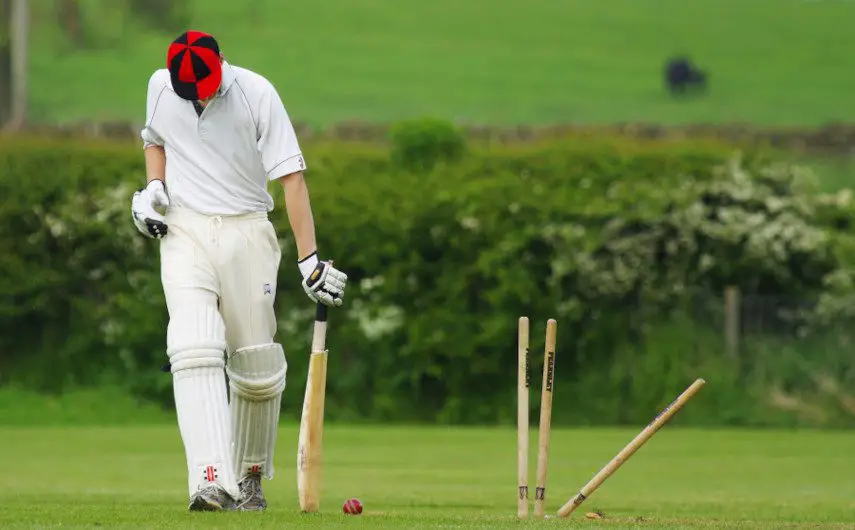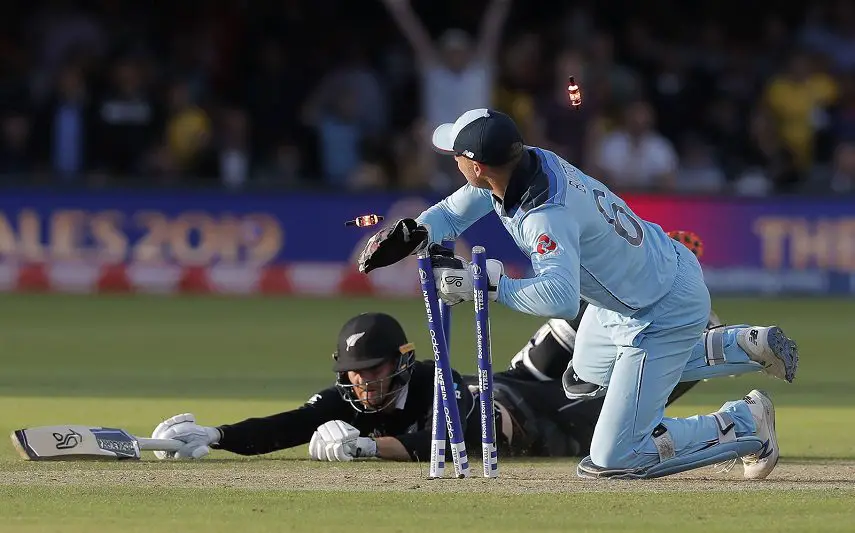Table of Contents
Test cricket is the longest form of the sport and it’s the one that attracts the so-called ‘purists’. Based on the original laws, this is simply the first class game played at an international level.
From the early days of the 1870s, and the first game at the Melbourne Cricket Ground, test cricket has grown from the original two participating nations to include other countries with test status from across the globe. It has more international competition in the modern day but, the key difference between this and limited overs matches, is the length of time involved.
What is Test Cricket: Rules
How is Test Cricket Played?
Test Cricket matches are played between two teams and generally, five days are available for the duration of the game. Only those teams with official test status can play.
Each of the sides involved gets to play two innings each and the basic aim is to score as many runs as possible.
Unlike One Day Cricket and T20 games, there is no limit on those innings. Teams have ten wickets to play with and their innings will generally only end when ten batsmen have been dismissed. There is, however, an option to declare the innings at any time if the captain of the batting side feels they have enough runs to force a result.
The object is to score more runs than the opposition but this is another area where test cricket differs from the limited overs formats. Test cricket rules include that if the side batting last overtakes the opposition total without losing all ten wickets, they will win the match. If the bowling side takes all ten of those wickets before the target is reached, that bowling side will win.
If, however, the total is not reached and there are wickets still intact when play finishes, the match is declared a draw. A draw is only possible in test and first class cricket.
How Long is a Cricket Test Match?

Traditionally, test matches are played for up to five days. There have been occasions in the past when games were ‘timeless’ and would only come to a conclusion when the match had run its full, natural course.
In the modern day, there have been occasions when four-day test matches have been played. These will generally occur when a strong nation plays one of the weaker sides. For example, recent four-day tests have been played between South Africa v Zimbabwe and England v Ireland. More recently, England announced a four-day test match against Zimbabwe in May 2024. However, the vast majority of test matches have five days available.
A minimum of 90 overs are put aside for each day’s play. The two teams in competition each have two innings to play during this time. Each innings will come to an end when the team has lost all of its ten wickets or, the captain has the right to declare that innings at any stage.
First class cricket (including test matches) is unique because there are four possible results – a win for either team, plus a draw and a tie. A tie is rare and only two of these have ever occurred in nearly 150 years of test match cricket.
Wins are achieved when the side batting last either passes their opponents’ score or, they lose all of their second innings wickets while they are still below that target. Matches are drawn when time runs out and the team batting at that point still has wickets in hand.
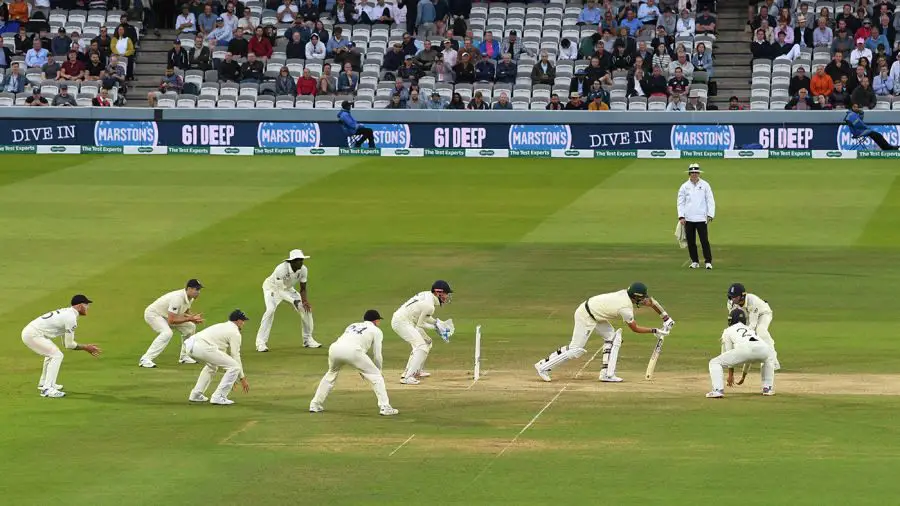
The Structure of a Test Match
The Toss
Before each match begins there will be a coin toss to determine which team bats and which bowls first, with both the umpires and the match referee present. The home captain will traditionally toss the coin and the away skipper will call heads or tails.
Sessions
Each day of a test match is split into three sessions – morning, afternoon and evening. Each of those sessions is scheduled to last approximately two hours.
Breaks
There are two scheduled breaks for lunch and tea: Following the morning session, there will be a lunch break lasting 40 minutes. At the end of the afternoon session, tea will take 20 minutes. When the evening session concludes, the close of play will be called.
In addition to the above, there will be an innings break when each innings comes to a close. This will last for ten minutes.
Overs and the New Ball
90 overs are scheduled for each day and, if those overs are not completed by the cut off point at close, the game will continue as long as weather conditions, including the light, allow. If bad light or rain force the players to leave the field of play at any stage, the umpires will look to make an early start on the following day in order to make up the lost overs.
At the start of the test match, the fielding side will be given a brand new ball which is intended to be used in 80-over spells. At the end of those 80 overs, the fielding team will be able to continue with that ball or they can elect to take a new one.
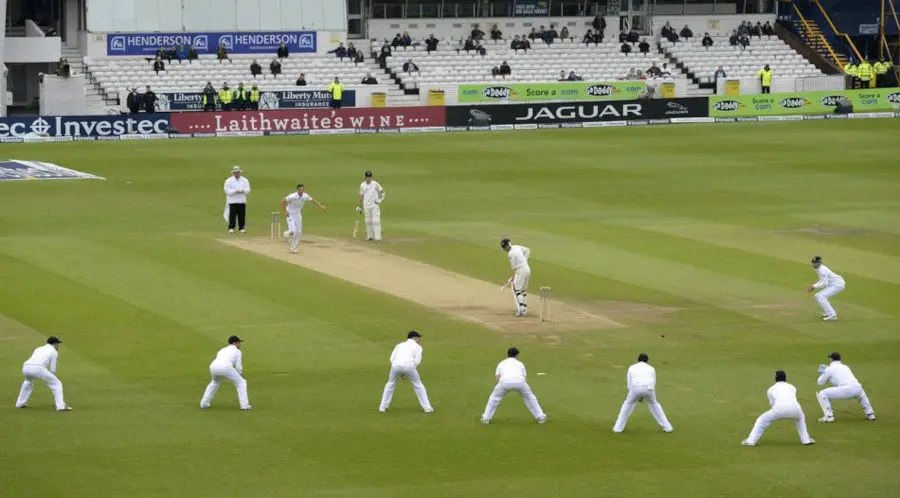
Decision Review System (DRS)
The two umpires are the arbiters of play but, in modern test match cricket, they have some assistance. In 2011, the Decision Review System was introduced so that the two teams could challenge decisions in relation to dismissals such as LBW or Caught Behind.
Each side will usually have the potential to use three reviews for each innings. However, this is a relatively new part of the laws which has been constantly updated so this position may change in the near future.
Follow-On Rule
Test and first class cricket also involves a twist to the rules, optional to the leading side’s captain after the first innings of the match to enforce the side batting second in the first innings to bat again straight away.
This is known as the follow on. If the team batting second are 200 runs or more below the opposition total, they may be asked to bat again.
Countries with Test Status
As of 2024, there are 12 countries who have been granted full test status by the International Cricket Council (ICC). Those countries are:
- England
- Australia
- India
- Pakistan
- New Zealand
- South Africa
- Sri Lanka
- Bangladesh
- West Indies
- Zimbabwe
- Ireland
- Afghanistan
There are other nations affiliated to the ICC but these are Associate Countries. Those sides can play recognised limited overs games but they cannot, at present, take part in official test matches.
Other national sides can also play representative games under first class rules but these are not official test games. The situation is, however, fluid and open to change at any time in the future. Ireland and Afghanistan were granted official test status as recently as 2017 and both have been full member countries of the ICC ever since.
The International Cricket Council also has the power to strip a country of test status as Zimbabwe have found in the past.
Day Night Test Match
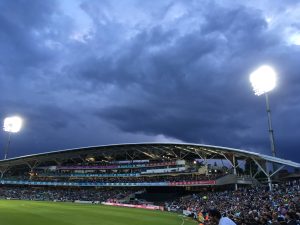
Test Cricket has to compete with the shorter forms of the game which have started to attract bigger audiences. Traditionally, test cricket is played during daylight hours but since most grounds now have floodlights, the concept of day night cricket has been trialed in many parts of the world.
The first day night test match was played between Australia and New Zealand in 2015 and there have been several additional matches in England, New Zealand and India since that point. The laws are essentially the same with sessions and breaks lasting for the same periods of time. The only difference here is that the hours have been pushed back. Play will start while there is some daylight remaining, but the floodlights will be switched on and nighttime will shortly follow.
One key difference lies in the colour of the cricket ball. Instead of the conventional red, day night cricket employs a pink cricket ball.
In 2024, day night cricket is still in an experimental stage. Some purists feel that the ball swings too much for a test match and that the games tend to finish too quickly. Over time, there will be more cricket of this kind but those early conclusions could potentially be an issue.
Why is it Called Test Cricket?
There is some speculation as to how test cricket got its name. The term has been used in common sporting language for so long that there are some conflicting opinions in relation to its origins. The most plausible explanation states that the phrase was first used some time in the 1860s – some ten years before the first test match was actually played.
In the 1861/62 season, an English team was taken to Australia by HH Henderson and it played in a number of colonies around the country. Although these were not official games between two nations, they were referred to as ‘tests’ simply because they were considered to be trial games and a true test of the players’ abilities.
The term stuck and was used for the first ever official ‘test match’ between Australia and England in March 1877.
Why is Test Cricket Considered to be the Best?
While limited overs cricket games, including One Day and T20 matches will always have their places on the schedules, the majority of serious followers feel that test cricket is the best of the four formats. To an extent, the clue is in the name and this form of cricket really is the ‘biggest’ test of a player’s credentials. Batsmen still need to score runs but they must also apply levels of patience and stamina that just aren’t needed in the limited overs forms.
Therefore, five day long conventional test matches will examine a batter’s skills far more than a one day game. The same applies to bowlers who may have to deliver 20 overs or more in a day’s play. All of their qualities will be put to the test in this time and they have to focus on taking wickets rather than keeping the runs down as they would in the limited overs formats.
Fans of test cricket also feel that there are more twists and turns to a match that is played for up to five days. Those without the necessary patience feel that this is a long time but it offers so much scope for strategy to play a bigger part. In short, it’s the original and purest form of cricket which has lasted for nearly 150 years and for most players and spectators, test cricket will always be the best.
Is Test Cricket Dying Out?
With so many new fans attracted to the shorter forms of the game, there is a theory that test cricket will eventually die out and be replaced. It’s a genuine concern for many cricket fans, and while it’s hard to imagine a time when test cricket doesn’t exist, the format is under pressure.
Test matches certainly need to be more entertaining. Nobody wants to see teams bat at a low run rate on flat pitches where there is no assistance for the bowlers. Statistics show that draws are becoming far less frequent and that’s definitely a positive thing.
Over in England, coach Brendon McCullum helped the team adopt a more aggressive approach. The media used the term ‘Bazball,’ to describe a method where the batters attacked virtually every delivery that was bowled to them.
It may be entertaining, but it’s a controversial method that has seen many English test batters lose their wickets to poor shots. Perhaps a balance is needed, because while there is that entertainment factor, some games are over in less than three days.
Attendances in some parts of the world are better than others. In the Pakistan v England series of 2024, crowds were low, while the grounds in Pakistan would generally see more spectators in ODI and T20 matches. It’s a similar situation in the West Indies where fans tend to prefer the limited overs formats.
In summary, test cricket won’t die out, but the players have a responsibility to make sure that it remains as the pinnacle of the game.

